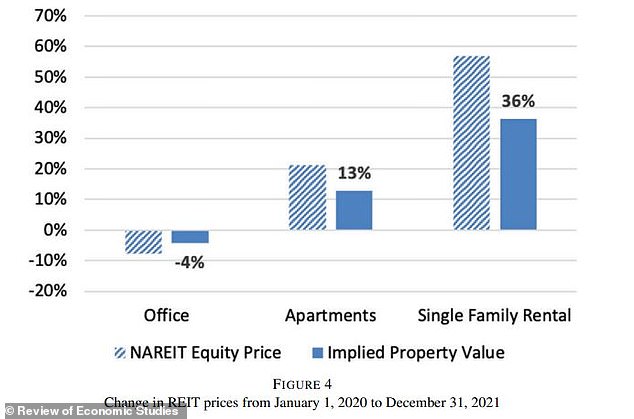How WFH has ‘radically’ changed the US workforce: real estate prices have risen 25%, workdays spent at home have quadrupled and income equality has ‘worsened’ as white-collar workers ditch city centers for suburbs, report finds
The Covid-19 pandemic has “radically” changed the US labor market, as white-collar workers leave city centers for the suburbs.
A report from Rutgers University evaluated work trends from the early 2000s to 2022.
The researchers found that even though working from home has been around for more than two decades, more than four times more Americans left the office between 2019 and 2022.
This led to employees being up to 80 percent more productive.
However, the increase in working from home has also caused housing costs to skyrocket.
This is especially true for suburban homes, as they have more space for home offices.
Researchers at Rutgers University found that housing costs have risen 14 to 25 percent since the Covid pandemic, with workers demanding space for home offices to spend more time working from home.

Researchers are still unraveling the long-term effects of the pandemic, although recent studies have found that working from home has led to larger waistlines and higher rates of depression and anxiety.
The team found that suburban home prices have risen by nearly 25 percent, and homes near urban areas have become 14 percent more expensive.
They warned that this could lead to a worsening of income inequality, as more productive work from home is largely only available to ‘highly qualified’ workers.
Dr. Morris Davis, lead author of the study and professor of finance and economics at Rutgers University, said: ‘The COVID-19 pandemic caused a radical shift in the extent to which people worked from home, which in turn increased the productivity of working from home as a result of mass adoption of remote working technologies.”
Researchers are still unraveling the long-term effects of the pandemic, although recent studies have found that working from home has led to larger waistlines and higher rates of depression and anxiety.
In the new study, researchers evaluated the amount of work workers did at home, productivity and the cost of housing in urban and suburban areas.

Researchers found that suburban home prices have risen by almost 25 percent, and homes near urban areas have become 14 percent more expensive since the Covid-19 pandemic.
In 2019, approximately five percent of all employees’ full working days were done from home.
This varied depending on education level, as it was nine percent for those with a bachelor’s degree or higher, 10 percent for those with an advanced degree, and two percent for those with a high school diploma or less.
However, the team found that this amount quadrupled between 2019 and 2022.
The team said this increase in work-from-home days is also leading to greater productivity. ‘The research in this article estimates that the improvement in total factor productivity from a day of WFH over a day in the office, which is needed to generate a fourfold increase in the number of days working from home, is large: 48% for low-skilled workers . and 82% for highly skilled workers,” the team wrote.
However, more time to work from home and evidence that this is more productive have led to increases in house prices.
The team found that in that same time frame, the price of suburban homes – which typically have more space for a home office – increased by 24 percent.
In addition, homes near urban areas where offices are located have become 14 percent more expensive.
“The change in productivity of working from home has also increased demand for housing,” says Dr. Davis.
The researchers predict that improving productivity from remote work will lead to a further increase in income inequality as remote work technology becomes more widely available and needed by highly skilled workers.
They said this is consistent with evidence that rising income inequality since the 1970s is largely due to technological innovation that benefits highly skilled workers.
‘It is predicted that the increase in productivity will lead to higher lifetime incomes for workers in occupations with tasks that can most easily be performed at home – mainly highly skilled workers – and so a side effect of the increase in productivity from working from home is an increase in income inequality,” said Dr. Davis.
The study is one of several in recent years that have shed light on the pros and cons of pandemic isolation and working from home.
For example, a 2023 report found that Americans walked 36 percent less than in 2019, which researchers blamed on working from home.
And researchers in Britain found that Brits consume almost 800 extra calories when they follow a hybrid schedule and take 3,500 fewer steps.
The research was published in the journal on Thursday Review of economic studies.
